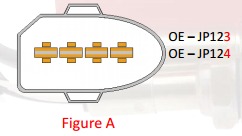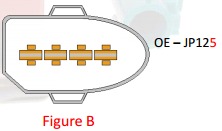Before we begin Part 1 of our series ‘Understanding Car Parts,’ there’s a few things we need to clarify about OE Parts:
- Car Manufacturers (e.g. Ford) don’t manufacturer car parts, they manufacturer cars. They mostly assemble car parts which are bought from Car Part Manufacturers (e.g. Bosch Car Parts).
- OE stands for “Orignal Equipment” – It refers to the ‘factory fitted part‘. OE and Genuine refer to the same thing.
- Car Part Manufacturers (e.g. Bosch) who supply parts directly to Car Manufacturers (e.g. Ford) are referred to as OEM (Original Equipment Manufacturer)
What are OE Parts?
An OE Car Part refers to any car part fitted to a vehicle from production/factory. It stands for Original Equipment and refers to any part which was originally fitted to the vehicle.
As previously stated, the OE part is the same as ‘factory fitted part’ or ‘genuine part’. It won’t usually be manufactured by the car manufacturer themselves, but by an Original Equipment Manufacturer (OEM) who are a manufacturer of original car parts; Bosch, Mahle, Delphi, TRW, Lucas, Valeo, Hella are all examples of OEM.
Since OE refers to original part it is often considered to be the best in terms of quality as one assumes the OE Part manufacturer must adhere to the original specification of the Vehicle Manufacturer.
Aftermarket Parts
Aftermarket Part refers to any part which is not OE; OE Parts are replicated/copied by lots of different companies. Another term for an aftermarket part is ‘Pattern Part.’
E.g. Honda Accord/Civic 2.2 Mass Air Flow Sensor. The OE (original) part is/was made by Hitachi. OE (Honda) Part Number is 37980RMAE01. In this case the OEM is Hitachi.
But this part will be available on the aftermarket (i.e. from non-dealership parts shops) who will offer the same part by different aftermarket part manufacturers.
E.g. Delphi Part Number AF10180-12B1 is equivalent to the OE Part number 37980RMAE01.
It is normal to fit aftermarket parts to vehicles and all garages/mechanics will replace OE parts with aftermarket parts when they need replacing. Is this bad? Not at all – as long as the garage/mechanics fits a reputable aftermarket brand (OE Quality – see later) you shouldn’t worry because the aftermarket part will function the same as the OE part. Note that in the above example, the OEM for that Honda car is Hitachi, but it is also offered by another OEM called Delphi, and although Delphi is not the OEM for that model Honda they are considered to be an OEM because Delphi are also a company who supply parts directly to vehicle manufacturers but for other car models.
 Finding which brand originally made the any one part on the car is not easy, and in most cases the only option is to look for the brand name on the part itself.
Finding which brand originally made the any one part on the car is not easy, and in most cases the only option is to look for the brand name on the part itself.
Difference between OE and OE Quality?
So we have disguished between OE and Aftermarket, but there is another confusing term called “OE Quality“. OE Quality refers to a quality assurance certification which is given to Aftermarket Manufacturers to say ‘this company produces parts which match or exceed the quality of the original.’ Note that “OE Quality” and “OE” don’t refer to the same thing. There is an European Regulation which states that when an OE Quality certified part is fitted to a vehicle it should not invalidate the car’s warranty.
Below is an example of an OE Quality Certification statement:
“Blue Print components are specified to perform to the same standards as original equipment and to meet or exceed the matching quality requirements as detailed in the Block Exemption Regulation EC No. 46/2010. According to this regulation, the correct installation of such parts will not invalidate the vehicle manufacturer’s warranty.”
Many car parts brands are accredited with OE-Quality Certification but there are still variations in quality between different brands. Deciding which parts are better quality will often come down to Brand Reputation.
Is the OE part always the best quality?
Mostly OE is best, but unless you happen to know who the OEM is, the OE Part will only be available from the car’s dealership and this means it will be much more expensive. Also, there are examples of when the OE Part is not so durable or has a design flaw; this can lead to the part becoming a ‘common failure’ or ‘common mot failure’ – in these cases other part manufacturers may decide to tweak/modify the original part so that it is stronger/more durable than the original to prevent further failure. Such examples are common in suspension parts like anti-roll bar links, stabiliser links and ball joints, where the aftermarket offer a heavy duty version of the original part.
Some aftermarket manufacturers like First Line or ADL Blueprint have a high reputation for producing excellent OE Quality parts and there will be odd examples where the aftermarket version of the part is better than the original.
Sometimes the original OE Part is redesigned midway through the vehicle’s production. Such events contribute to complications like ‘part choices’ or ‘part options’ where the same model/specification car uses a certain part like e.g. brake pads will fit only up to a specific chassis number, and after this chassis number it needs a different OE Part.
So which parts should I buy?
There are a few things to consider:
Price.
Because we often don’t know which company made the original part, OE Parts are usually bought from a Dealership. Dealerships are expensive and you can Buy Cheaper Car Parts from a multitude of other motor factors and stores which sell Car Parts Online.
OE Quality is OK
Aftermarket/Pattern Parts produced by reputable brands, who have OE Quality Certification, are widely accepted and used by the industry when a OE/Genuine/Original Part needs replacing. OE Quality parts will not invalidate your vehicle’s warranty.
What Part is it?
The type of part required is often a factor to consider. For example, many experts will say that it’s always better to use OE or OEM parts when replacing Engine Management Parts, like Mass Air Flow Sensors, EGR Valves and Lambda Sensors. This is because there are many diagnostic stories (maybe myths?) of cases where the aftermarket/pattern part did not turn off the fault light, but the OE or OEM part did. Conversely, when buying consumable parts and regular service items like brake pads, filters, suspension parts etc it might not be so crucial to look at OE or OEM. For Clutch Kits we always advise you buy a reputable OEM brand because fitting a clutch is an art and not all mechanics will have success installing a non-OEM clutch; Luk Clutches are Clutch Specialists and widely considered to be the best clutch brand.
Final Verdict: Buying OEM Brand Parts is the best of both
At Doctor Car Parts we choose our brands carefully. On all our product pages there is information about the brand including whether it’s an OE Quality Brand or an OEM Brand. Whenever possible we would advise to choose OEM Brand because this gives proper OE Quality from a parts manufacturer who is reputable enough to supply to vehicle manufacturers direct. Many OEMs will source and buy parts from other OEMs meaning it will often be the OE Part in the box (i.e. it will be manufactured by the same company who supplied the factory fitted original part).
I think that leaves us with only one thing to say…..


